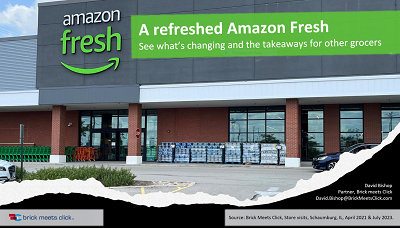4 reasons why grocers who compete online need a broader view of the eGrocery market
Complete the form below to instantly download this month's dashboard.
Competing online is a challenging endeavor that requires knowing the landscape and understanding which paths to pursue and how. For brick-and-mortar grocery retailers, mapping the plan is even trickier since there isn’t a well-worn path to follow.

While staffing the team with people who have eCommerce experience can certainly help, it’s not enough. These folks often come from outside the industry, and selling groceries online is very different from apparel or electronics (just think fresh foods).
So, whether you’re a seasoned grocery professional or a digital expert who now works for a grocer, you will benefit from seeing the bigger eGrocery picture to learn who’s shopping online, where are they doing it, and how they’re using this mode to supplement their in-store trips and purchases.
Obtaining this broader perspective, however, is difficult unless you have access to Brick Meets Click’s monthly State of the U.S. eGrocery Market Report . This report is specifically designed to help brick-and-mortar grocers navigate these disruptive times by providing objective research and that broader view.
Here are four reasons why you need the State of the U.S. eGrocery Market Report .
1. Get information that’s relevant, meaningful, and timely
Have you ever requested information about online grocery shopping from partners or suppliers only to find that it isn’t very helpful? If yes, the issue could be that this is all they have or that they don’t know where to go to get this type of information. Either way, we have the solution.
The State of the U.S. eGrocery Market Report provides data points over time about how online grocery shopping is evolving – how households shop online, whether they shop across retail channels, and which ways they receive orders. And all of this is anchored by examining key business questions that are vital to improving elements of strategy and execution.
The report delivers relevant, meaningful, and timely information that can help you identify opportunity gaps – and clear and compelling evidence that will help you communicate internally with executives and others.
2. Harness a single source of information from the household POV
Do you find it challenging to reconcile information from disparate sources to get a clearer and sharper picture of the market? Piecing together data from different sources is one way to build the bigger picture, but ironically, this can complicate those efforts or cause a loss of confidence in what it shows from the retailer’s vantage point.
The value of having a single source of information – the household – is one key reason why grocers appreciate our approach. The State of the U.S. eGrocery Market Report captures how many households are going online each month, where they are shopping, and how much are they spending online in context of their overall grocery spending.
This point of view gives you the overall picture of how the online market is performing, plus comparable metrics at the channel level (Grocery, Mass, Club, etc.). You also gain insights into the drivers of the top-line sales results as well as channel-level metrics that measure household penetration, and monthly order frequency and average order spending.
3. Leverage the findings to strengthen planning and strategy efforts
Are you frustrated when someone suggests your eCommerce team pursue the latest “shiny object” because of an article they read? Preventing your team from being distracted by these types of diversions is essential to developing stronger strategies.
The State of the U.S. eGrocery Market Report serves as a treasure-trove of evidence that you can mine to educate the organization and inform the decision-making process. Our approach examines key business questions that grocers have, like “How does online grocery usage compare across age groups?” and “How many households buy groceries online from each retail format?”
The report’s findings equip you with current and relevant information, based on a single source of data, to examine the key questions on the minds of grocers so you can make more informed recommendations to improve outcomes for your business.
4. Influence what you want to learn about your customers
Do you want to identify where you can refine your strategy and/or see how it’s being executed to improve your performance? It’s hard to do those things if you can’t see the opportunity gaps, and that’s where the report provides an objective, outside view that can be used for comparison purposes.
The State of the U.S. eGrocery Market Report offers a framework that grocers can adapt internally to measure and monitor their respective business in a similar way. Monitoring elements like order frequency, average order value, and the likelihood to reuse a service again within the next 30 days can help reveal gaps in execution that may be causing lower repeat rates compared to industry-wide or channel-specific benchmarks.
In this way, the report can influence the ways in which your internal insights or research teams monitor the health of your online business segment and reveal opportunities related to your customers, competitive position, and capabilities.
Don't miss another month of this important info
Brick Meets Click remains committed to delivering the online grocery research and context that grocers need to succeed in today’s online/in-store market – via our reports, related discussions, and the add-on support services.
As everyone is trying to figure out the post pandemic “normal,” it’s time for you to give this report a try. Plus, once you subscribe, you have the option to schedule a call to discuss it either one-on-one or with your whole team.
LEARN MORE about this report (available via 1-month or 4-month flex subscriptions).

David Bishop , Research Lead and Partner at Brick Meets Click, develops projects that help conventional grocery retailers define and defend their business by making more informed decisions in a changing marketplace.











